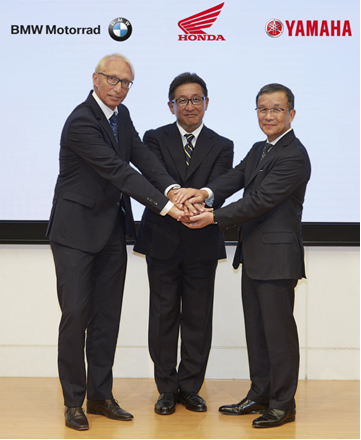Motorcycles become part of the connected vehicle world
October 7,2015
Bordeaux/France, October 6,2015 – Yamaha Motor Co. Ltd.(Tokyo:7272) , BMW Motorrad and Honda Motor Co. Ltd. are now collaborating to enhance Cooperative-Intelligent Transportation Systems (C-ITS) applications in powered two-wheelers (PTWs) and working together to establish a consortium named Connected Motorcycle Consortium. According to the Memorandum of Understanding (MoU), which was signed by all ACEM manufacturing members in 2014, C-ITS features will be introduced from 2020 onwards (ACEM: European association of motorcycle manufacturers, www.acem.eu). In order to accelerate this process, the three manufacturers will begin their cooperation in the field of C-ITS now.
The new cooperation was announced on October 6th 2015 at the ITS World Congress in Bordeaux (France), the world’s largest event for intelligent transport systems and services. The three partners also encouraged other motorcycle manufacturers to join the consortium so as to further increase safety in powered two-wheelers.

Executive Vice President Development BMW Motorrad
Tetsuo Suzuki,
Operating Officer at Honda Motor Co., Ltd.
Takaaki Kimura,
Executive Vice President and Representative Director of Yamaha Motor Co., Ltd.
"In order to speed up more motorcycle-specific safety developments, we intend to cooperate to promote a successful implementation of C-ITS in motorcycles and scooters," says
Mr Tetsuo Suzuki, Operating Officer at Honda Motor Co., Ltd.. Mr Takaaki Kimura, Chief General Manager of Technology Center and Executive Vice President and Representative Director of Yamaha Motor Co.Ltd. adds: "Our companies are already active members of the Car2Car Communication Consortium, in which we work with car and truck makers and other stakeholders on common specifications and standards. We came to realize that the specific requirements of motorcycles are beyond the scope of this consortium, however. The next logical step is to enter into a cooperation dedicated solely to the challenges relating to powered two-wheelers."
"Our aim is to promote a timely and comprehensive use of cooperative ITS systems in powered-two wheelers offering the potential to improve safety. We therefore encourage other companies to join us," explains Prof. Dr. Karl Viktor Schaller, Executive Vice President Development BMW Motorrad.
The European Motorcycle Manufacturer Association welcomes the initiative
Antonio Perlot, ACEM Secretary General, stated: "This initiative is fully in line with the ACEM road safety strategy and shows the willingness of the motorcycle industry to increase safety for riders based on very concrete and practical developments."
ITS technologies will contribute to motorcycle safety
If well considered and properly deployed, ITS technologies offer the potential to further increase safety, security and efficiency in all transport systems, in particular for motorcycles.
Intelligent Transport Systems (ITS) require the integration of information and communications technology including transport infrastructure, vehicles and users. Basic applications currently exist in GPS navigation systems, where real-time traffic information is provided such as rerouting advice based on traffic jams ahead. For road transport in particular, interoperable networked wireless communication between vehicles can enable road users to make coordinated and informed decisions about their route as well as allowing safer manoeuvring in busy urban environments.
ITS technologies are expected to generate particular safety benefits in regard to powered two-wheelers (PTWs), not least by offering a level of ‘electronic communication’ which can be shared between riders and drivers of other road vehicles.
The three companies have already gained experience of connected vehicle technology in several European field tests. Together with car makers and major suppliers, BMW Motorrad participated in simTDTD (www.simtd.de), a large scale field test carried out on connected vehicles in the greater Frankfurt area in Germany. Honda and Yamaha participated in DRIVE C2X (www.drive-c2x.eu), a Europe-wide ITS field test project.
In view of the challenges experienced in these real world tests, the three manufacturers are now joining forces to evaluate the principles of cooperative intelligent transportation systems (C-ITS) to enhance motorcycle safety.
Motorcycle ITS systems will be different from those for cars
ITS systems designed for cars cannot simply be transferred to motorcycles. Due to the limited space available, electronic systems have to be smaller and be resilient to water, dust and vibration.
Since motorcycles exhibit different driving dynamics, software development and algorithms need to consider special requirements.
You might receive this press release from the three partners at the same time.